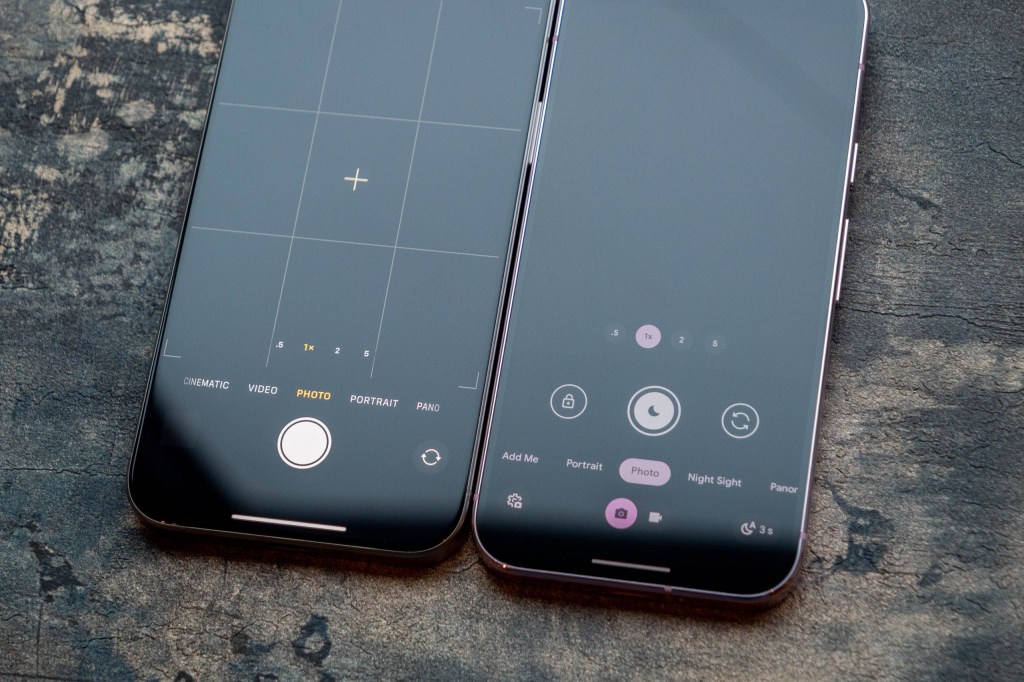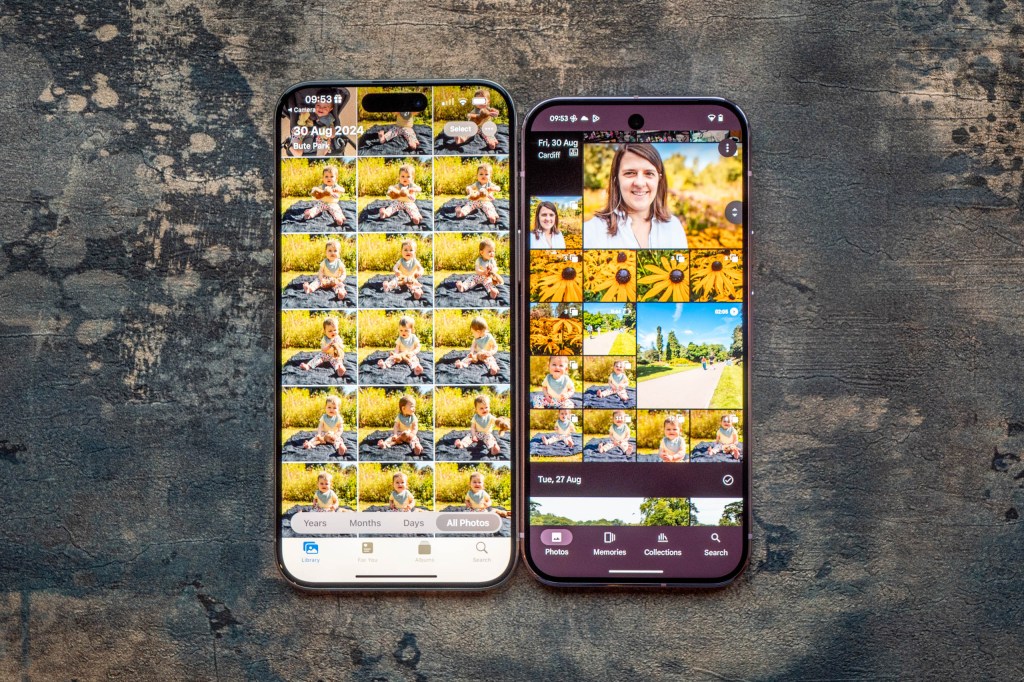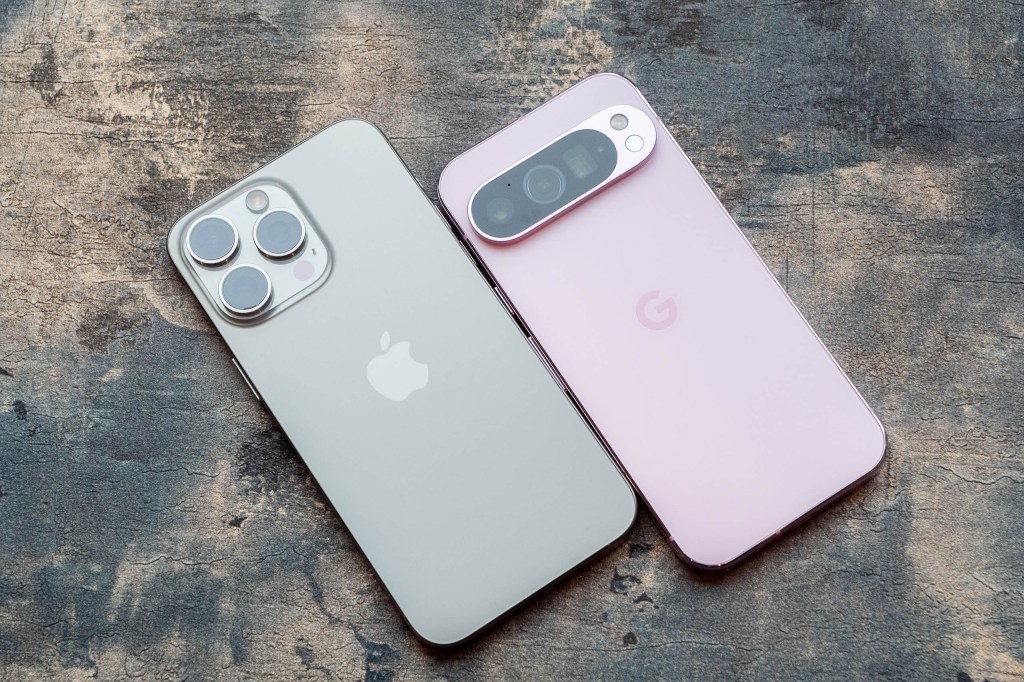Both the Google Pixel range and the Apple iPhone series pride themselves on the quality of the onboard cameras, with both appearing pretty high in our list of the best smartphones for photographers. But, what will be the result of a Google Pixel 9 Pro vs iPhone 15 Pro Max test?
In this piece, I’ll be taking a look at how the two models stack up against each other, using them both in a number of different scenarios to get a better idea of which is the best that you can spend your cash on.
It’s worth noting that it won’t be long until the iPhone 16 Pro series makes its debut, but, as many will still be looking at – and thinking about buying – older models then it still makes sense to take a closer look at how these two popular choices compare.
Here I’ve been using the Pixel 9 Pro, which is the smaller phone compared to the Pixel 9 Pro XL. However, both have exactly the same camera setup. For this reason, this piece can also be considered as a Pixel 9 Pro XL vs iPhone 15 Pro Max comparison too.
Camera specs
Both of these flagship models offer a triple-camera array, which is a fairly common setup on many different smartphones now – especially among flagship devices. The two also have the same type of offering to, with a 1x, 0.5x (ultrawide) and 5x (telephoto options).
There are some key differences however. All three of the Pixel’s sensors are high resolution, with a 50MP main sensor, with an f/1.68 24mm equivalent lens, which is joined by a 48MP sensor with an f/1.7 12mm equivalent ultrawide lens and an additional 48MP sensor with an f/2.8 110mm equivalent telephoto lens.
By comparison, the iPhone 15 Pro Max has only one high-resolution sensor – the main 1x camera, with its 48MP sensor and f/1.7 24mm equivalent lens. The other two sensors are a 12MP f/2.2 13mm equivalent lens and another 12MP f/2.8 120mm equivalent lens.

Both models offer digital zoom, with up to 30x for the Pixel, and up to 25x for the iPhone. Google claims that its 10x digital option is “just as good” as a 10x optical lens. With either model, there’s a 2x option which uses the central portion of the main sensor for “lossless” quality.
For the selfie cameras, the Pixel has been upgraded quite significantly over the 8 Pro series, and is now a much higher resolution at 42MP (with an f/2.2 lens), compared with a 12MP sensor (with an f/1.9 lens) for the iPhone.
Both models offer 4K video recording at 24/30/60fps. Google is touting “8K video” in its promotional materials for the Pixel 9 Pro series, but, this is upscaled 4K footage which needs to be sent up into the cloud and downloaded later, so it’s not wholly a fair statement to say it records 8K. There’s a host of other video features for both devices, including slow-motion options.
If we’re looking only at “on-paper” specs, then the Pixel 9 Pro/XL comes out on top here, with three high-resolution sensors, and a better selfie camera. We’ll see how those extra pixels help in our real-world sample images, soon.
Camera apps and shooting modes
Both the Pixel and the iPhone range have become known for offering a fairly straightforward way of shooting through the native app, though both have added more and more features and modes over the years.
Of the two, the Pixel 9 Pro is the only one to include dedicated “Pro” options, giving you the option to change a variety of shooting parameters such as shutter speed, white balance and ISO. With the iPhone 15 Pro Max, all you can change is exposure compensation. Both give you the option to shoot in raw format (DNG) from the standard Photo shooting mode.
In terms of other modes, both have a Portrait mode, but the iPhone’s has far more options, such as the ability to change the lighting mode, and to shoot with a longer focal length too. I also like the fact that with the iPhone, it will automatically recognise a portrait subject, even when shooting in the normal mode, so you can add portrait effects later down the line.

Both have a low light mode – it automatically activates with the iPhone, whereas with the Pixel you can choose it independently (it’s called Night Sight). Both have macro shooting capability, with both automatically activating should you bring the phone close to a subject.
The Pixel has some additional modes which make use of AI, including Action Pan and Long Exposure. A new “Add Me” feature for the Pixel 9 series allows you to create group portraits without having another photographer / a tripod available and is pretty clever.
When it comes to in-phone editing, the Pixel again makes greater use of AI to give far more retouching tools. This includes the Magic Editor, where you can move objects around the frame, and erase them, while there’s also Best Take, which you can use to ensure that everybody in a group shot is smiling / not blinking. Apple appears to be working on something similar for its own phones, with the beta of iOS 18 demonstrating a new “Clean Up” tool, which at this stage still seems to need some refinement.
For video, there’s standard shooting modes for both models, as well as some additional tools you can use. For the iPhone we’ve got Cinematic, Action and ProRes. For the Pixel, there’s Blur and Pan, but there’s also the option to Video Boost your files to 8K – this is 4K upscaling which requires sending your videos off to the cloud, so is arguably of limited use.
The winner here has to be the Pixel 9 Pro series for its range of diverse options and fun features, but, if portraits are your thing, the iPhone is still better.
General image quality
You’ll be able to get great photos with both of these phones in a wide range of different conditions, with, as we usually find to be the case, the best results in good light. Both show off a nice degree of detail, with well-balanced exposures and with nice, vibrant colours.


I’d say on the whole, colours from the Pixel are slightly nicer, while still sticking to the right side of natural, and it also seems to have a greater dynamic range. The iPhone at times can produce greener tones than I’d like. The ultrawide angle lens also produces nicer images than the iPhone 15 Pro Max’s, likely thanks to having a higher resolution sensor and a wider aperture lens.


Looking at images shot under artificial light, the Pixel 9 Pro has made the shot look more “correct” – we can see that the iPhone 15 Pro Max shot has far yellower tones. However, I should point out that the real scene was quite yellow itself, so I’d say the iPhone has kept things truer here, even if the Pixel is a more pleasing shot overall. When the light is artificial, but less yellow, the phones produce similar colours.
Overall, both of the phones put in a great performance, but we might be able to pick out some more differences if we look at specific scenarios.
Zoom
Both the iPhone 15 Pro Max and the Pixel 9 Pro have a 5x telephoto lens with an f/2.8 maximum aperture, so it would be safe to assume they’d give fairly similar results. However, there is one big difference to consider – resolution. The Pixel has a 48MP sensor behind the telephoto lens, while the iPhone 15 Pro Max has only a 12MP sensor.


In real-world usage, in good light, I find that both offer reasonably similar levels of detail, with perhaps a touch more from the Pixel if you’re looking pretty closely (which of course most people using their phone won’t be).
Now looking at digital zoom options. You can get a bit closer with the Pixel 9 Pro (30x) than the iPhone 15 Pro Max (25x). The Pixel’s 30x zoom picture is slightly better than the iPhone’s – but I wouldn’t want to use either very often, perhaps for a record shot if I was absolutely desperate.


I can see a much bigger difference if I look at images shot at 10x. This is something that Google promises it can deliver at as good a quality as a real optical zoom lens. I might not go that far, but the 10x digital zoom from the Pixel is better than the iPhone’s, and it’s certainly usable on social media and the like.
Here I’d give the Pixel the edge, for its mid-range digital zoom actually being usable.
Low light
I’m very impressed with the low light performance from both the iPhone and Pixel – you can get excellent results from either.


With the 1x lens, results are relatively close. I just about prefer the colours of the iPhone picture in this specific test, but sometimes it can be the other way around. Detail seems to be fairly well matched between the two.


With the ultrawide lens, I expected the Pixel to produce a better result, but there seems to be more detail in the iPhone shot – both are great though and would look fantastic on social media.


Again, I was expecting a touch more detail from the Pixel’s 5x lens, but here it’s the iPhone which has come out a little better, with some very noticeable smudging in the Pixel version.
Overall, I’d say the iPhone 15 Pro Max has performed better here – which is a little bit of a surprising result. They are very closely tied, however – it’ll be interesting to see what improvements Apple brings to the iPhone 16 Pro series in this area.
Macro
With either of these phones, an automatic macro mode will kick in if you bring the phone close to a subject. It’s not something you can choose manually. When you do it, the phone will switch to the ultrawide lens, then crop to maintain the 1x lens angle of view. You can switch off macro focusing if you don’t want to use it.
The main difference here is that the ultrawide lens for the Pixel has a 48MP sensor and a wider aperture (f/1.7 vs f/2.2) than the 12MP ultrawide sensor found in the iPhone 15 Pro Max.


When I look at images shot in bright light, both put in a fairly good performance. It’s hard to avoid stepping into the path of light when you have to get so close to the subject. To that end, these days we’re seeing much better results from smartphones which use the telephoto lens for macro work – such as the Xiaomi 14 Ultra.
I’d say the two here are pretty evenly matched. If you’re only going to be examining your shots on your phone, both put in a perfectly adequate performance.
Portraits
Although both have a dedicated Portrait mode which you can use, it’s only the iPhone which has automatic portrait recognition. As the owner of both a baby and a dog, that’s something I find comes in handy very often – when you’re moving quickly with an unpredictable subject, it’s great to be able to sort things out after the fact.
With the iPhone 15 Pro Max, you can create portraits at 1x, 2x or 5x focal lengths. With the Pixel 9 Pro, you can only use 1.5x or 2x – which seems a bit restrictive for anybody that wants to create either headshot type images, or showing the environment off.


Both produce very nice results in Portrait mode, with fairly realistic outlines from either model. Both can struggle a little with fine hair, but so long as you’re not pixel peeping, you’ll likely not notice it all too much in either situation.
Although there’s more options with the iPhone’s Portrait mode, it’s worth giving a special mention again to the Add Me feature, which you can use to take pictures of you and another person without having to get anybody else involved – and that’s pretty neat. If that’s something you think you’ll be doing a lot, it’s arguably worth getting the Pixel for that alone, but that’s up to you.


The iPhone 15 Pro Max has a 12MP selfie camera, while the Pixel 9 Pro has upgraded its selfie camera from the 8 Pro, now having 42MP (but it’s still output at 10.5MP). Both have autofocus and both can be combined with Portrait mode for shallow depth of field effects. Both produce pretty good results, but the colours from the Pixel are nicer. There’s more detail in the Pixel – which isn’t necessarily a good thing when it comes to selfies, but it’s there nonetheless.
Overall, I’d say the iPhone is a little better here, thanks to its greater versatility – but special mention for the Add Me feature.
Video
Both of these phones have very good video specifications. With either, you can record 4K at 60fps, with a range of other resolutions and frame rates available.
The results from either are great, offering vibrant colours and plenty of detail. Those who create extra functionality from video might be drawn towards the iPhone for its “ProRes” offering, but there’s arguably more “fun” options from the Pixel 9 Pro.
Neither has a “Pro” video shooting mode, such as you might find with the Samsung Galaxy S24 Ultra, but for most creators, either are more than adequate.
Again to note that the Pixel claims to offer 8K video recording. This is something which is a “boost” feature – you record it as 4K and it’s boosted online via the cloud, allowing you to later download an upsampled file. It takes a long time for that to be processed, so it’s not an elegant solution for anybody who genuinely has a desire for 8K video recording.
Here I’d say we’ve got a tied situation between the two.
Screen and Design
With the Pixel 9 Pro series, we have two screen sizes to choose from. For the smaller Pixel 9 Pro it’s a 6.3-inch screen, with 2856 x 1280 pixels. For the Pixel 9 Pro it’s a 6.8-inch display, with 1992 x 1344 pixels. Both are “Super Actua” LTPO displays, with both offering up to 2000 nits maximum brightness and up to 120Hz refresh rates.
Meanwhile, the iPhone 15 Pro Max is slightly smaller than the 9 Pro XL, with a 6.7-inch screen. It’s a “Super Retina” LTPO display, with 2796 x 1290 resolution, 120Hz refresh rate and also 2000 nits maximum brightness.

In terms of toughness, the Pixel 9 Pro uses a Corning Gorilla Glass Victus 2 screen, which should make it pretty tough. But, the iPhone 15 Pro Max uses a ceramic shield, and after nearly a full year of use I’ve yet to scratch it, so that’s pretty good going. Both are IP68 dust and water resistant – you can fully immerse either phone for up to 30 minutes and it should be fine.
Dimensions wise, the iPhone 15 Pro Max (159 x 76.7 x 8.25mm) is smaller than the 9 Pro XL (162.8 x 76.6 x 8.5mm), as we’d expect, but the 9 Pro (152.8 x 72 x 8.5mm) is smaller again. The iPhone 15 Pro Max weighs 221g, which is actually the same as the Pixel 9 Pro XL, and slightly heavier than the 199g Pixel 9 Pro.

Aesthetics wise, it seems to me that the Google and Apple designers went to the same phone-designing course, as they’re very similar. Both have that sort of squared-off round corners and flat screen, so from the front they’re very similar indeed. The iPhone uses a bigger cut out at the top for its selfie camera and facial recognition, but that bar can also be used for other purposes too.
Battery life, charging and storage
The Pixel 9 Pro has a 4700mAh battery, while the Pixel 9 Pro XL has a 5060mAh – a difference we’d expect between two different sized devices. Both promise a battery life of over 24 hours – the 9 Pro’s smaller battery should last about the same amount of time as it doesn’t have such a large screen to power.
Apple meanwhile don’t divulge the exact size of its batteries, but they also promise to last for 29 hours for the iPhone 15 Pro Max. In my experience of using both devices, either easily lasts a full day unless you’re doing lots of things which use intensive data – such as navigating via Google Maps and so on.
The base storage size of the Pixel 9 Pro series is 128GB, which is a little on the low side by most modern smartphone standards. You can also get a 256GB version, a 512GB version, and for the 9 Pro XL only, a 1TB version – with price increments to match. For the iPhone 15 Pro Max, the base storage size is 256GB, with a 512GB and 1TB option also available.
Price
It used to be that the Pixel series offered far greater value for money than the likes of the comparable iPhone or Samsung equivalent. They’re still a little cheaper than their nearest rivals, but the gap has closed significantly.

One benefit of having the smaller screen size available for the Pixel 9 Pro series is it can be picked up at a cheaper price point. It starts at £999 for the 128GB model, while the cheapest you’ll be able to get an iPhone 15 Pro Max is £1199 (albeit with 256GB storage as there is no 128GB version). You could opt for the iPhone 15 Pro if you’re happy with a slightly different camera set up. With that model you can also get a 128GB version, which will set you back £999, just like the Pixel 9 Pro.
If you want a larger Pixel 9 Pro XL, the cheapest available is £1099 (128GB), or £1199 for the 256GB version – again putting it exactly in line with the iPhone 15 Pro Max.
The most expensive Pixel 9 Pro XL is the 1TB option at £1,549, which is slightly cheaper than the iPhone 15 Pro Max’s £1599 for the same storage size.
Verdict
It can be quite tricky to choose between two high-end flagship smartphones, and it’s safe to say that it’s a tricky task here too.
Both the iPhone 15 Pro Max and the Google Pixel 9 Pro / XL put in a great performance across a wide variety of situations, so you should be pleased with either if you buy them.
Images from the Pixel 9 Pro are just a little bit better in most ordinary situations, and for zoom. However, I prefer the images from the iPhone in low light and for portraits – so really it depends on the type of work that you do most often.

In terms of looks, that’s down to personal preference, but the designs here are actually pretty close. I like the colour options of the Pixel more, but that might be just me.
Price wise, these two are pretty much evenly matched. However, as the iPhone 15 Pro Max is older, you might be able to get some good second-hand deals already. Additionally, it’s worth considering that the iPhone will likely keep its value a bit better in the long run when it comes to selling it on or trading it in in the future.
On the whole, these models are very closely matched, and there’s no super clear winner. If I had to pick one, it would likely be the Pixel 9 Pro for general image quality, but both are excellent.
Which would you choose?
Related reading:
Follow AP on Facebook, Twitter, Instagram, YouTube and TikTok.






